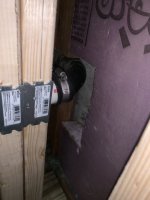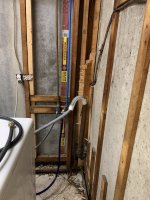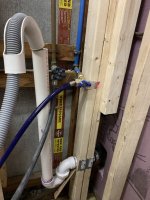Quan Vo
New Member
I am having an issue with water overflow on the washer standpipe. We clogged and there wasn't anything blocking the pipe. I tested with the water supply hose for a few mins and ran into no issue. However, depends on the wash cycle, the volume of water discharged from the washer causing overflow. I recently moved the standpipe from the other wall to this new location and it happens. We weren't sure if this has happened before or not. I used 2" PVC for most everything, the standpipe height is 2 feet, but the main drain is old and only 1 1/2". I appreciate any help and advice. I suspected the discharged water is too much for the main drain to handle? Also, I added a 90 degree elbow to relocate the pipe to this wall, it used to be on the right-hand sidewall, where the purple foam board located, wonder this addition would slow down the flow?

Last edited:



